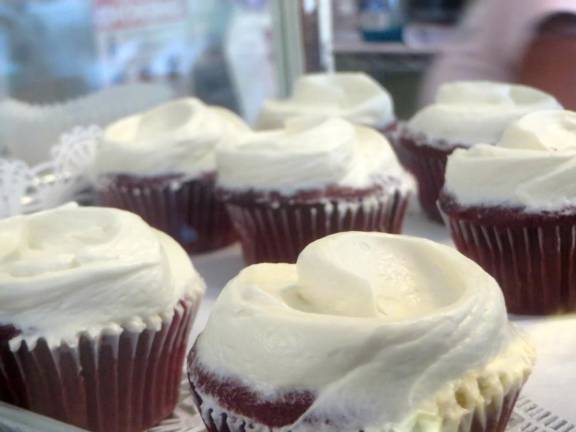Cupcake Pandemic
Magnolia Bakery announces plans to install new far-UVC lighting - but the city health department isn't so sure about safety

Only in New York could the leading edge of building back from the pandemic be a cupcake store on the Upper West Side, guided by a Columbia professor and a guy who helped NASA light the International Space Station, while a city agency looks over their shoulders and worries that their plans may not be safe - or wise.
The cupcake store is Magnolia Bakery, of "Sex and the City" fame, which announced that to stop coronavirus it would shine a new kind of ultraviolet light, called far-UVC, on customers and staff at their Columbus Ave store, their distribution center in Harlem and, later, The Greenwich Village location where Carrie and Miranda downed cupcakes while discussing Aidan.
A joint statement with the manufacturer, Healthe by Lighting Science of Coco Beach, Florida, said Magnolia was the first business in New York City to announce plans to install the new far-UVC lighting, which its inventors say does not carry the risks to skin and eyes of more traditional UV light. Other companies plan to follow, a Healthe company spokesman said.
“Studies have shown that continuous low doses of far-UVC radiation results in no harm to humans,” Healthe explains in a sales brochure. “The far-UVC light does not penetrate thetop layer of the skin or the tear layer of the eye.”
But the city agency, the Department of Health and Mental Hygiene said it was not convinced this is such a good idea at the moment. “With businesses contemplating reopening, it is understandable that business owners want to keep their employees and customers healthy and safe,” the department said in a statement released by Deputy Spokesman Pedro Frisneda. “The Health Department urges business owners to comply with state and city requirements concerning routine cleaning and disinfection, physical distancing and use of face coverings.”
The statement offered two separate concerns. The first was that installing the lights might be misunderstood as an alternative to social distancing, mask wearing and sanitary measures. “Taken together, these strategies substantially reduce the risk of COVID-19 transmission,” said the health department, which monitors food safety and, of course, is also at the center of fighting the pandemic.
The second concern appeared to be about the innovation itself. “Until the value and safety of new technologies is assessed, the Department does not recommend these technologies – nor can they be a substitute for city and state mandates,” the statement said.
Magnolia’s Chief Baking Officer, Bobbie Lloyd, said it had never crossed her mind that she might need the city’s blessing to put in lighting fixtures. She said Magnolia had gotten overwhelmingly positive reaction to the announcement both in the United States and from international locations.
She said her husband, who has autoimmune illnesses and keeps tabs on medical and scientific developments, had first called far-UVC to her attention even before the pandemic hit. Then when it did, she sought out Healthe to see if she could install the lighting at Magnolia’s locations. She is expecting delivery of the equipment any day.
"Champion of Change"
Both the Columbia professor who developed far-UVC and the Chief Scientific Officer of Healthe stressed that the far-UVC lighting was an added measure of defense against infection not a substitute for other measures. "It won’t replace wearing a face mask in places were we should wear face masks,” said Fred Maxik, the founder and chief science officer of Healthe.
During the Obama Adminstration Maxik was honored as a “champion of change” for, among other things, helping NASA install human-friendly lighting inside the International Space station.
He has been working on the far-UVC light with Professor David Brenner of the Columbia University Irving Medical Center. “This is an add-on to everything else we do,” Brenner said. “If we start rejecting all the lessons learned over the last couple of months, we’re asking for trouble.”
Brenner has been developing the far-UVC light for years. He recently announced that it destroys coronaviruses floating in the air, a worrisome form of transmission. He has also been testing the light on mice for months now and says there are no signs of ill effects.
In its sales brochure Healthe sites a 2018 paper by Brenner and colleagues in support of its safety claim. However, that paper focuses on tests that show the far-UVC effectively destroys microbes. It does not include controlled tests on people.
Exposure Thresholds
The Health department did not offer any guidance about how it might decide if the far-UVC light was safe for use in occupied public spaces. There are no Federal Occupational Safety or Health standards for UV light exposure.
An industry professional association, The American Conference of Governmental Industrial Hygienists, does set exposure thresholds, but these have been based on traditional UVC light and have yet to be updated for the new far-UVC light, according to David Sliney, who ran the Army Medical Corps radiological unit for many years.
Sliney suggested that these thresholds are probably more stringent than they need to be. But raising them requires a process to consider all factors and implications, he said.
Meantime, the Metropolitan Transportation Authority announced this week that it was running a pilot program to test far-UVC in unoccupied subway cars during disinfection. Transit officials said they were intrigued by the possibilities of far-UVC for reducing infection risks in occupied subways and buses but were proceeding methodically. “In government,” one said, “you don't want to be on the cutting edge of technology. Maybe just the leading edge."